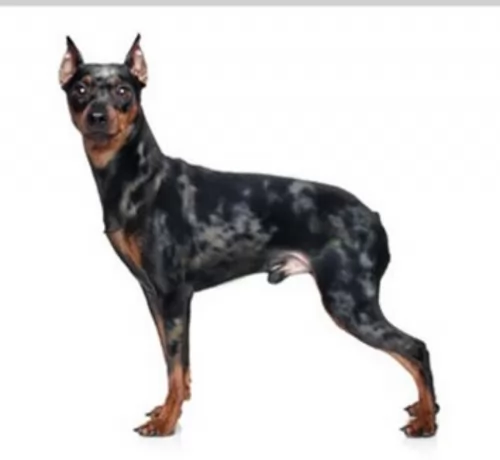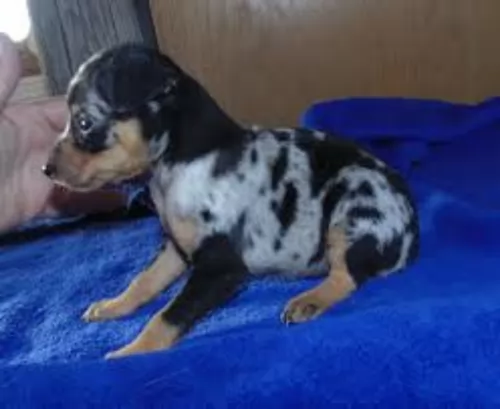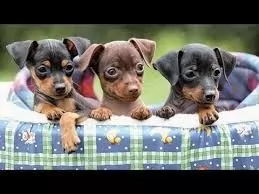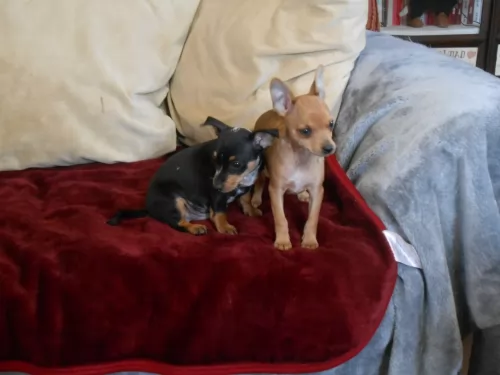 MyDogBreeds
MyDogBreedsTurnspit Dog is originated from United Kingdom but Harlequin Pinscher is originated from Germany. Both Turnspit Dog and Harlequin Pinscher are having almost same height. Turnspit Dog may weigh 9 kg / 20 pounds more than Harlequin Pinscher. Both Turnspit Dog and Harlequin Pinscher has same life span. Both Turnspit Dog and Harlequin Pinscher has almost same litter size. Both Turnspit Dog and Harlequin Pinscher requires Low maintenance.
It is amazing that this small dog’s popularity comes from him being used in the kitchens to roast meat. The British enjoyed eating their meat which they roasted on a fire.
These dogs were essentially regarded as a tool – a means to an end, and when kitchens were modernized, they were no longer needed, and they became extinct.
Referred to as the kitchen dog or cooking dog, the first mention of these little dogs was made in 1576. By 1850 the dogs had become scarce and by 1900 it seemed as though there were none left.
 This toy-sized dog is a type of Miniature Pinscher originating in Germany. The dog was developed by crossing traditional Miniature Pinschers with other toy-sized short-haired terriers. He falls into the Terrier category.
This toy-sized dog is a type of Miniature Pinscher originating in Germany. The dog was developed by crossing traditional Miniature Pinschers with other toy-sized short-haired terriers. He falls into the Terrier category.
The dog was used to kill rats, but has always been a devoted pet at the same time. They nearly became extinct after World War II, but the breed was once again restored. Today it is an established breed, but it isn’t recognized by any of the major kennel clubs.
In fact, The Harlequin Pinscher Association is the only breed club that recognizes the Harlequin Pinscher. It can be registered with the Harlequins Pinschers Association or with the American Canine Association.
The Turnspit was a small long-bodied dog, standing at between 20 to 30cm in height and probably weighed anything between 9 and 14kg in height.
The legs were somewhat crooked or bandy and Edward Jesse, who wrote ‘Anecdote of Dogs’ in 1846 described them as ugly dogs with a miserable look to them. That was probably due to him having to fit into the hamster-like wheel contraption that turned the meat being roasted in the kitchens.
They were low-bodied dogs, similar to a Dachshund or a Corgi with short, stocky legs, short floppy ears, and a short coat. The long tail curled over its back. It is believed that the coats were white, reddish-brown, gray or black.
The dog was certainly feisty, energetic and hard-working with not much being written about his temperament. He was a working dog, but given the chance, he would no doubt have been loving and loyal, longing for the chance just to be part of a human family and to be loved.
 This is a small compact dog standing at 25 – 33cm in height and weighing about 3kg to 4 or 5kg. He has dark eyes and ears which are set high and which are erect with just the top of them folding forwards.
This is a small compact dog standing at 25 – 33cm in height and weighing about 3kg to 4 or 5kg. He has dark eyes and ears which are set high and which are erect with just the top of them folding forwards.
The legs are straight and thin with small cat-like shaped paws. The tail is traditionally cropped, but these days the tail is left longer. He has a short coat which is available in a range of colors – black, brown, red, fawn patterns of merle, brindle or piebald. The Harlequin Pinscher is like a Bambi or a small deer, especially when they're a bit long in the leg.
Alert and inquisitive, the Harlequin Pinscher is a feisty, devoted little dog, brave and loyal and he has a lot of energy. He is intelligent too and with training and socialization, he becomes such a pleasure to have around, obedient and responding well to instructions.
He is known to be good with other pets as well as with children, so long as the children have been taught to respect animals. As always, a dog pretty much turns out the way the owners are, and with training and firmness while being patient and fair, you don’t have to worry about your Harlequin turning into a ‘small dog syndrome’ animal – whining, snappy and disagreeable. He is actually described as a big dog in a tiny dog's body.
The Harlequin Pinscher is a social dog and wants to be with you wherever you go.
The Turnspit dog had a tough life, but would no doubt have made a wonderful little pet had he just been allowed to be a companion dog.
Make sure that when you buy a dog, you don't just put him in your backyard and forget about him. Give him the love and care he deserves.
 The Harlequin Pinscher may have once been good at catching rats but these days they are much more sought after for their ability to be a splendid companion and pet.
The Harlequin Pinscher may have once been good at catching rats but these days they are much more sought after for their ability to be a splendid companion and pet.
He is such an entertaining, social little dog, wanting to spend as much time with you as possible. He is fearless, energetic, playful, confident, loving and intelligent and those who have owned them say they are courageous way beyond their size.
He is strong willed, stubborn and confident and this larger-than-life dog is just waiting to show you what a wonderful friend he can be to you too.
The health and lifespan of a dog is influenced by quite a few things such as food, care, love, exercise and the type of breed it is. Generally smaller dogs live longer than big dogs, and mixed breed dogs live longer than pure breeds.
The Turnspit dog, if he had received the proper care, could have lived to between 10 and 15 years of age.
Stress can bring on a sudden drop in blood sugar. The Turnspit had reason to be stressed, working hard in horrible conditions. Dogs become weak and lethargic and can scarcely maintain an even gait. A sudden drop in blood sugar can cause a small dog to go into a fatal coma.
This ailment seems to occur more often with smaller dogs. The pancreas becomes inflamed and your dog has vomiting, diarrhea, abdominal pain and dehydration. Pancreatitis can come about because of trauma, metabolic disorders or infection.
 Harlequin Pinschers, just like other dog breeds, have health issues that they are prone to such as epilepsy, dental issues, obesity and Patellar Luxation.
Harlequin Pinschers, just like other dog breeds, have health issues that they are prone to such as epilepsy, dental issues, obesity and Patellar Luxation.
Some seizures in dogs are genetic or related to illness. A dog could have ingested something poisonous while a head injury can also cause seizures in dogs. If your pet has a seizure you may notice foaming at the mouth, drooling or twitching of the legs.
After a seizure you could see your dog walking in circles and bumping into things. It is important to get your pet to the vet as soon as possible.
A dog is man's best friend, but the Turnspit was essentially just a working dog and most likely didn’t receive the proper care he deserved.
Small dogs like these would have had basic needs. Their owners would have had to pay attention to the dog's health, because he needed to work.
We look at ways in which a small dog like the Turnspit should have been cared for -
One wonders if the Turnspit was allowed to eat any of the roast meat he worked so hard on to get ready. Every dog should have a regular meal.
Most adult dogs should be fed 2 meals of kibble a day. If the Turnspit wasn’t extinct he would have required a high quality ‘small dog breed’ commercial dog food. Home-made food would also be a requirement – some boiled chicken, brown rice and vegetables. Dogs want and appreciate simple, wholesome foods that won’t upset their digestive systems.
Along with good food, dogs need cool, fresh water constantly available to stay healthy.
Make sure he gets to the veterinarian if he is sick, but also for his vaccines to prevent him from getting some of the worst dog diseases there are.
Groom your small dog regularly. The Turnspit had a shortish coat and would have required a brush twice a week. Other grooming procedures for a small dog like the Turnspit would have been keeping his nails trimmed and checking the inside of his ears and his mouth for ear infections and dental disease.
 The short, smooth coat of the Harlequin Pinscher is easy to maintain, shedding little. With such a small, nimble dog, you can even take a damp cloth and wipe him down. You can brush him down once or twice a week to keep his coat healthy and shiny.
The short, smooth coat of the Harlequin Pinscher is easy to maintain, shedding little. With such a small, nimble dog, you can even take a damp cloth and wipe him down. You can brush him down once or twice a week to keep his coat healthy and shiny.
Dogs can develop dental problems such as tartar and plaque build-up. and this can lead to canine dental problems which can turn life-threatening as bad teeth affect the heart, kidneys and the liver.
You need to brush your pet's teeth 2 or 3 times a week making use of canine toothbrush and toothpaste. Never use regular human toothpaste for your dog as it can be poison to him. It is why dry kibble is better than soft food as the soft food sticks to the dogs teeth.
Your Harlequin Pinscher is also a member of the toy breed group and he has high energy levels. Always choose a high quality kibble for a small dog breed and also which is in keeping with his age and activity levels. He will do well on a high quality dry commercial food, some raw meat or home-cooked food such as chicken, brown rice, pasta and vegetables. If your dog is an energetic dog, he will benefit from a diet rich in protein.
It will be tempting to feed your little pet tasty treats such as chocolate, nuts, coffee and milk but be careful as these can cause severe digestive problems with your dog.